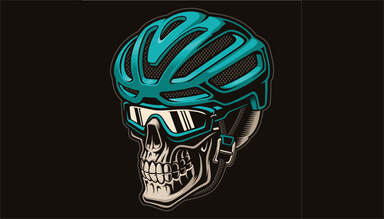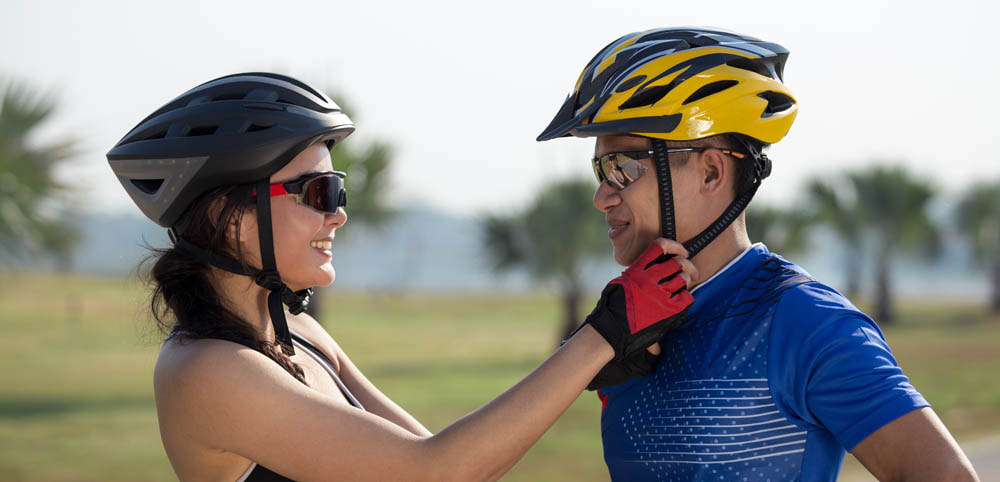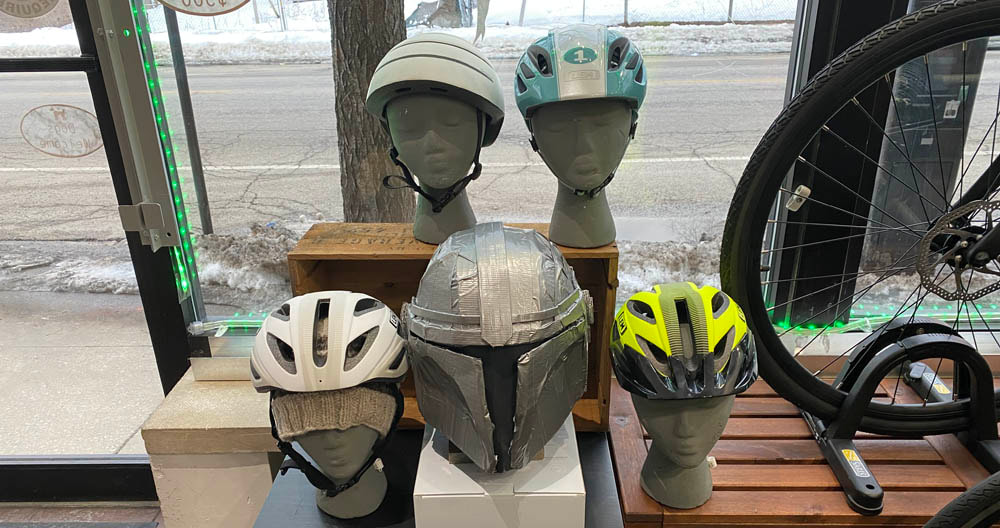 Wearing a helmet makes sense whenever you ride a bike. With the variety of styles and prices for new bike helmets you might be confused about how to choose one. They provide different head coverage, ventilation, and features, utilize different materials, are available in different sizes and price points and it is valuable to know which of these are important and which are just personal preference. Here are the things you need to know before selecting a helmet to assure you get the safest coverage of your head for your rides. Check the Safety Rating of the Helmet An alarming number of bike helmets are being sold in the US that are not certified, so do not assume that all the helmets available online or in a store meet the required safety standards. To be legally sold in the United States, there is a federal law that says all bicycle helmets in the market must meet the standards the Consumer Product Safety Commission (CPSC) established in 1999. There is talk about updating the standard, but this is the one manufacturers currently must still meet. The standard specifies a series of safety tests that must be conducted and how the helmet must be labeled. Consumer Reports did a check and found helmets for sale online from Amazon.com, Sears.com, AliExpress.com and LightInTheBox.com that did not display the proper safety certificate. They contacted each marketplace and the helmets were removed, but others continue to creep up when not monitored. Counterfeit helmets are also an issue, where they display the name of a reputable manufacturer but are in fact not from them. Here is what is required by the CPSC and what you should look for in a helmet:
If a helmet does not have the proper labeling, it does not mean the helmet is definitively unsafe, but this cannot be determined without testing and without the label they may not have been tested according to CPSC standards. The lack of a label itself or an improper label makes the helmet non-compliant, meaning they should not be sold in the US. There is a separate safety standard European CE, which is not as rigorous but even if a helmet might pass the CPSC tests, just meeting the European standard in itself, does not enable it to be sold legally in the US. Some manufacturers have created multi-use helmets design to be used for more than one sport, such as skateboarding, in-line skating, and riding a kick scooter, in addition to biking. Before using a multi-use helmet for biking, make sure it has CPSC certification. If you find you've purchased a helmet without the proper labeling indicating it does not meet US safety standards return it immediately and notify the marketplace or store. Your most reliable place to purchase a helmet is to walk into a local bike shop with second choice being a big box store. Online is most risky and where the most subterfuge occurs. Understanding Helmet Construction Safety testing is designed to establish the effectiveness at protecting the head from the impact force of falling off a bike. Modern helmets as designed to do this with an inner liner, outer shell, straps, and a buckle and the Bicycle Helmet Safety Institute, a consumer funded volunteer organization, has a web site that does a good job identifying the components. Liner The liner is the most important part of the helmet and consists of a foam layer where the energy of a crash is managed. Liners are mostly made from Expanded Poly Styrene (EPS) foam, a high-grade form of Styrofoam. For most low end helmets, granules of EPS known as "bead" are placed in a mold and expanded with steam and pressure into foam. Top end helmets require internal reinforcement to enable larger vents and to ensure the helmet does not split on impact. The manufacturing process is unique to each manufacturer. Common materials are nylon, polypropylene, metal, or mesh for reinforcement. EPS is laid in layers with different densities to accommodate impact, with softer layers to crush in lesser impacts and harder layers for harder hits. Density may vary around vents. Fitting pads are often hook and loop mounts glued in and the pad attached to the liner. This allows the pads to be removed for cleaning or to apply pads of different thickness for comfort. Some have more complicated proprietary interior liners. On low end helmets the pads are often glued in. Rotational forces are known to cause brain injury. To counteract these, designers utilize different methods with the following names: Multi-directional Impact Protection System (MIPS), WaveCel, SPIN. These are designed to provide a slip-place of additional layers that slide on impact to redirect the rotational forces. These additional layers add cost but for the most part research has not concluded that these are a must have feature. Consumer Reports evaluates and rates helmets but many of their top-rated and recommended models do not have MIPS or a similar rotational force reduction technology. Shell The plastic shell on the exterior of the helmet provides a way to keep the liner inside in place, keep it clean, resistant to scuffs and denting, and provide structural support for the ventilation holes added in the liner. Low end helmets use stamped PET, the same material used for bottled water or something similar which is usually glued onto the liner, then taped around the edge for appearance. The fact that the shell is smooth, round, and slick allows the helmet to slide on impact to protect your head and neck. Vents should be smoothly faired into the helmet shell. On higher end helmets the shell is included in the mold when the liner is expanded from the bead. Most use another material, polycarbonate or other plastic that can take the heat of the mold and no glue is necessary. This could lead to a stronger helmet, but manufacturers usually use this as an opportunity to add larger vents and reduce the foam as much as possible and this is a trade off in order to still meet the CPSC impact standard. Skate-style and BMX helmets are made with hard shells made of ABS or polycarbonate plastic with a composite hard shell, layers of fiberglass, Kevlar, or carbon fiber laid up in epoxy. Graphics in the form of stickers are usually applied on the shell and may be treated with a clear coat. Straps Helmet straps look similar but vary in fabric, finish, weave, and color. For helmets with a glued on shell, straps are usually made from nylon or polypropylene and added to the liner before the shell is glued on. This is not possible when the shell is included in the mold since the heat of the molding process would damage the webbing so straps are added after it comes out of the mold with an anchor mechanism. Ideally you want a strap that is easy to adjust to achieve a good fit without excessive fiddling. Once adjusted the settings should stay put. The rear of high end helmets usually has an occipital stabilizer. This may be a strap, knob, cam, or slider that allows adjustment to fit the occipital lobe, the lump on the back of the head. This adjustment is used to help assure the helmet is firm on the head and it can be used to make easy adjustments to accommodate a hairstyle change, sweat band, or hat that you may want to wear under the helmet without redoing the straps. Buckle The buckle, usually plastic or nylon with a side pinch release or D-ring buckle, is added when the straps are installed. Ideally you want a buckle that keeps the helmet on your head after the first impact (car) for the second impact (street) but releases to avoid strangling. Never wear a helmet with a broken buckle because it may affect the ability of the helmet to stay on your head in a crash. Select Helmet Features Common helmet features you may want to evaluate are:
You won't see much marketing around helmets or ads touting safety features because it raises potential liability issues. There are few ads claiming new models are safer than previous models or guaranteeing any helmet will provide protection from injury because if someone is hurt wearing the helmet the manufacturer might be sued. For this reason it is important to perform your own analysis. Purchase the Correct Size Helmet A helmet that fits your head size is important because if it does not fit it will not provide the most protection in the event of a crash. If a helmet is the correct size and shape, it will be more comfortable and you will want to wear it all the time on your rides. The easiest way to get a good fitting helmet is to go to a local bike shop and try several on. This is a good idea because manufacturers use their own shapes for helmet molds, so by trying it on at the store you can see if that brand fits your head shape comfortably. The other way to get the correct size is to measure your head, centimeters are the easiest. This is done as follows:
Here are the bike helmet sizing ranges for the most common helmets, but manufactures may vary from this, so always consult their sizing chart.
If you are in between sizes, go with the smaller size. A larger helmet might be made more comfortable by wearing a light weight cap or bandana underneath. Adults with smaller heads can wear a child-sized helmet. Adjust Your Helmet to Fit Properly Once you've purchased your helmet that meets CPSC requirements and is the correct size, you will want to adjust it so it fits well. The League of American Bicyclists education program teaches helmet fit with an easy to remember guidance: Eyes, Ears, and Mouth: Level - The helmet should sit level on your head so that when your eyes look up you can see the rim of the helmet, about two fingers width between the helmet rim and your eyebrows. Centered - The straps near the ears should form a "V' shape just below and slightly ahead of the ears which enables the helmet to be centered on the head. Firm Strap - The strap under the chin should be snug, with no more than two fingers distance between the chin and strap. If your open you mouth wide like performing a big yawn, you should feel a tug. Do not wear a helmet that is cracked, broken or missing any padding or parts. Fitting problems occur when a helmet does not sit comfortably due to the shape or bumps on your head. Other fit challenges are hair and facial hair styles including thick hair, braids, pony tails and beards. In these cases you should look for a different manufacturer or one made from a different mold or modify your hair style when riding your bike so the helmet fits properly. How to Care for a Helmet
Cleaning - Avoid using chemical solvents to clean a helmet--mild soap and water and a soft cloth or sponge and air drying is the best way to clean. Storage - Do not store in areas where heat can accumulate, such as an attic, garage, car trunk or in direct sunlight since heat can cause bubbles and weaken the helmet structure. Also avoid extremes of cold. Do not allow anyone to sit or lean on helmet and avoid dropping it. When to Replace - Helmets are designed to absorb a single impact so if you've wore it during any impact, it needs to be replaced even if it looks okay. The foam material in the liner may have crushed upon impact and may not offer protection in another crash. Even if you have been crash free, most experts recommend replacing a helmet after five years. Pollution, weathering, and UV light may weaken the structure over time. Predicting the Future of Helmet Technology 3D Printing - New manufacturing techniques are employing 3D printers to produce the complete outer shell enabling the possibility of each helmet being printed individually, enabling a custom helmet fitted to an individual rider's head. Materials - Materials such as Ultra High Molecular Weight Polyethylene (UHMWP) is in development for military applications and may trickle down to the liner of bicycle helmets. Fitting Systems - Better fiddle-free, instinctive fit systems that do not require constant recalibration that are in development will make adjusting a helmet quick and worry free. Visibility - Advances in film technology may result in LEDs to bring surface lighting to helmets and colorful graphics. Other Resources There's a lot of information about bike helmets on the internet and it can be overwhelming. You can always get help from the experts at your local bike shop. Here are some additional resources; Bicycle Review Guru - Bike Helmet Safety Bicycle Helmet Safety Institutehelmets.org Earth Rider Blog on How to Fit a Helmet Comments are closed.
|
Earth Rider Blog about CycingAuthorSharon Kaminecki and others comment on adventures in bicycling and other stories Categories
All
Archives
August 2023
|






